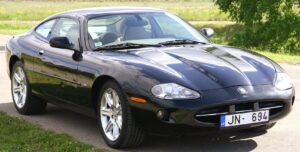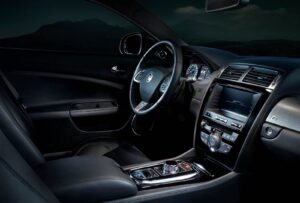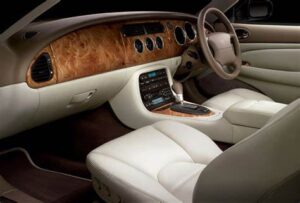Jaguar XK8 or XKR?
1. How the Jaguar XK8 and XKR came about
2. Potential pitfalls in buying a Jaguar XK8 or Jaguar XKR
3. For inspection before buying:
4. Jaguar XK8 and XKR – Price Guide
How the Jaguar XK8 and XKR came about
Jaguar XK8 or XKR? The Jaguar XK8 and XKR are luxury sports cars that were introduced by Jaguar in 1996. They were designed to be the successors to the iconic Jaguar XJS and represented a significant shift in Jaguar’s design and engineering philosophy. The XK8 and XKR were developed under the supervision of Geoff Lawson, Jaguar’s design director at the time, and they featured a modern and elegant design with a more aerodynamic and streamlined appearance compared to their predecessor.
The XK8 was powered by a 4.0-liter V8 engine, while the XKR, the high-performance variant, came with a supercharged version of the same engine. These cars were known for their comfortable interiors, advanced technology, and a balance between sportiness and luxury. The XK8 and XKR models remained in production until 2006, and they played a significant role in rejuvenating Jaguar’s brand image during that period.
Potential pitfalls in buying a Jaguar XK8 or Jaguar XKR
When considering buying a Jaguar XK8 or XKR, there are several potential pitfalls to be aware of:
- Maintenance Costs: These cars are luxury sports cars, and maintenance and repair costs can be relatively high. Ensure you have a budget for regular servicing and any unexpected repairs.
- Age and Mileage: Older XK8 and XKR models may have higher mileage, which can lead to more wear and tear. Be thorough in inspecting the vehicle’s condition, especially if it has been driven extensively.
- Electronic Issues: Some owners have reported electronic and electrical issues with these cars, including problems with the navigation system, climate control, and various sensors. A comprehensive inspection of the car’s electrical systems is advisable.
- Rust: Depending on the climate and how well the car has been maintained, rust can be a concern, especially in older models. Check for rust on the body and undercarriage.
- Supercharger Maintenance (for XKR): If you’re considering an XKR, keep in mind that the supercharger requires proper maintenance. Ensure it has been serviced regularly to avoid costly repairs.
For inspection before buying:
Engine:
- Start the engine and listen for unusual noises like knocking or ticking.
- Check for any signs of oil or coolant leaks under the engine bay.
- Inspect the condition of belts, hoses, and wiring for wear or damage.
- Ensure the engine runs smoothly and accelerates without hesitation.
Gearbox:
- Test the automatic or manual transmission for smooth shifting without jerking.
- Pay attention to any grinding noises when changing gears.
- Check the fluid levels and condition of the transmission fluid for proper maintenance.
Hood (Bonnet):
- Inspect the hood for any signs of rust, dents, or misalignment.
- Ensure that the hood latches securely and opens and closes smoothly.
- Check for a functioning hood support strut.
Suspension:
- Examine the suspension components for signs of wear or damage.
- Bounce each corner of the car to check for excessive bouncing or noise.
- Look for oil leaks from shock absorbers.
Exterior:
- Inspect the body panels for rust, dents, scratches, or paint imperfections.
- Check the condition of the headlights, taillights, and turn signals.
- Verify that all glass surfaces are free from cracks or chips.
- Check for proper alignment of doors, fenders, and the trunk lid.
Interior:
- Inspect the seats for wear, tears, or damage.
- Check the condition of the dashboard, door panels, and trim for cracks or fading.
- Test all interior electronics, including the infotainment system, climate controls, and power windows.
- Ensure that the interior lights and switches function correctly.
- Look for signs of water damage or musty odors, which may indicate leaks.
Wheels and Brakes:
- Examine the condition of the wheels for curb rash, cracks, or bent rims.
- Check the tire tread depth and ensure they have even wear.
- Inspect the brake discs and pads for wear and check for any brake fluid leaks.
- Test the brakes for responsiveness and any unusual noises.
It’s essential to perform a thorough inspection of each of these components to assess the overall condition of the Jaguar XK8 or XKR you’re considering purchasing. If you’re not confident in your ability to evaluate these aspects yourself, consider having a professional mechanic or a trusted automotive technician perform a pre-purchase inspection to provide you with a comprehensive assessment of the vehicle’s condition.
Jaguar XK8 and XKR – Price Guide
Price guide for the Jaguar XK8 and XKR models based on my last knowledge update in September 2021:
Jaguar XK8:
Older models in fair condition: €9,000 to €12,000
Mid-range models in good condition: €13,000 to €18,000
Well-maintained, low-mileage examples: €19,000 to €23,000 or higher
Jaguar XKR:
Non-supercharged XKR models in fair condition: €11,000 to €16,000
Supercharged XKR models in good condition: €17,000 to €24,000
Well-maintained, low-mileage supercharged XKR variants: €25,000 to €31,000 or more
Please note that these are approximate price ranges, and actual prices may vary depending on factors such as the specific model year, location, optional features, and the overall condition of the vehicle. It’s essential to research current market conditions and consult local listings for the most up-to-date pricing information when buying a Jaguar XK8 or XKR.
Are you already a proud owner of a Jaguar XK8 or Jaguar XKR? If so, check out our selection of parts for this car at the following link:
https://octoclassic.com/product-category/jaguar/xk8
https://octoclassic.com/product-category/jaguar/xkr
Photos sources: marinoperformancemotors.com, arinsh.com, pinterest.com, Parkers












